Find more tutorials and other Creative posts, and much more, at my new website,
Freely Whole!
Life! Liberty! Happiness!
The older posts here will remain.
Find more tutorials and other Creative posts, and much more, at my new website,
The older posts here will remain.
from Lisa @Me & My House! This blog is the everyday application of my foundational teaching on family and home, found on my website, in my seminars, and Me and My House exclusive resources. See also my everyday applications for Christian growth, biblical home education, health through nutrition, and 100% natural healthcare. Enjoy the journey of Discipleship for Life!™ {Not all articles have been moved from my old site to here.}
It’s been several years since I posted our experiments in making milk substitutes. We have been dairy-free for close to 20 years. Over those years we have tried soy milks, rice milks, raw goat’s milk and many others. For the last at least couple of years we have landed at homemade Almond Milk, (with raw goat’s milk being my 2nd choice.) So it’s time to do an update on making Not Milk, in this case, the easiest and highly healthful Almond Milk.
Soak Almonds in 2 cups Water several hours (overnight).
Drain and rinse well.
Put soaked Almonds and 4 cups water in high performance blender, and blend 45-60 seconds.
Pour through a Nut Milk Bag (or Unbleached Cheesecloth) into large bowl (I use an 8 cup Pyrex / Anchor Hocking measuring pitcher). Squeeze all the Milk out and pour into a 1 qt. covered pitcher or jar and Refrigerate.
Almond Pulp (remaining in bag/cloth) can be sealed in a container and refrigerated or frozen to be used in desserts, or dehydrated and ground into Almond Meal/Flour.
Options:
Tip! If you desire a “whiter” milk you can peel the almonds after draining and rinsing. Rub each almond between your fingers to remove the peel.
Tip! You can flavor the milk with Real Vanilla (bean, extract, flavor) if you desire.
You can also sweeten it with Raw Honey, Real Maple Syrup, or Dates. Just stir in the Honey or Maple Syrup after blending – about 2 tsp. – 2 Tbl. depending on how sweet you want it. Some also like to add just a dash of unrefined salt.
To sweeten with Dates, add 3-4 pitted dates, cut up, to the blender and blend with the almonds. If adding the dates, you will get more of a cream color, even if you peel the Almonds.
[subscribe2]
You know those little round circles of red felt on a sewing machine spool pin? Did you ever wonder what they are there for? Mine disappeared long ago, and I never worried about replacing them. Most machines I’ve ever seen or used didn’t have them, so I figured it wasn’t a big deal. I wasn’t too long ago that I found out they are to protect the paint under your spool of thread, as that spool constantly spins there. Ok, I knew it before, but I didn’t think it really mattered until I got old machines.
Now if you have a new plastic machine, your machine may not have them or need them. If you have a “modern” metal machine with the spool pin on the back, you may not care. But if you have an old metal machine with the spool pin on the top, you may decide it is worth protecting that paint. You don’t want to wear down that 75-100 year old paint any further. But perhaps you don’t really want an ugly red felt circle there either.
I prefer a pretty pink flower. I’d heard about and seen pictures of spool pin doilies. So much prettier than that red circle! So I decided to make some to dress up my old ladies. Even when those ladies themselves have seen better days, like Jocabed, my 122 year old Singer 27, this pretty little doily can dress her up far better than a red felt circle could.
Perhaps you think there should be other flowers in this garden. I didn’t stop at just pretty pink flowers. I decided to make some white ones out of #10 bamboo crochet thread (on Natalie, my 90 year old National 2 Spool).
And I tried a purple one out of #3 cotton crochet thread, because that’s the only size they had of purple, (on Ruthie, my 85 year old Singer 66). I wasn’t as thrilled with the #3 thread. Too thick, IMO.
If you’d like to make some Spool Pin Doilies for your sewing machine – new or old, you will need #10 crochet thread and a size D crochet hook. You can download my instructions /pattern. FREE to use, just don’t copy, repost, or claim it as yours. Instead share a link to this post (not to the file) so your friends can get their own Free Pattern. Thanks.
Enjoy!
[subscribe2]
It’s been over 3 months since I’ve updated on my Studio re-do. Many changes have been made, including complete rearrangement, but I still have a ways to go before it is finished.
The paper crafting station has moved. This is now my primary sewing corner, well, non-treadle corner anyhow. My “non-vintage” Riccar sewing machine and new Janome serger are on the sewing table, and 1956 Singer 99K, “Roxie Anne,” in the cabinet. The 2 machines not housed (on the floor) are my 1952 Singer 15-91, “Louise,” and the “Dressmaker” Japanese zigzag c. 1950s. I haven’t used them much yet, (the Dressmaker needs a cord and 15-91 could use a new one.) I’m still debating whether to make a cover for the wooden ironing board and use it, or leave it as is. The sewing box and child’s iron on the shelves are from my childhood. The red child’s ironing board is a recent find, as I don’t have my childhood one anymore.
Where my sewing machines were is now my storage and cutting area. I moved the trestle table back up from the family room, and put it back up on risers for a perfect height cutting and pressing table. The dresser holds sewing basics and other supplies in the drawers, a 1922 White Family Rotary sewing machine in the bentwood case, “Betty“, and a drawer that survived a fire, from my dad’s wife’s cabinet that held her 1948 Singer 201-2 “Pamela”. (Buttons are in the cigar boxes.) Yarn, and cutting and ironing tools are housed on the shelves. And yes, the fan works, and is a great addition to the room as the weather warms up. The rolling cart holds all my ribbon, and rulers for cutting. At the end of the cutting table is my National 2 Spool (c. 1925) treadle sewing machine, “Maggie“, after Margaret Thatcher born in 1925. (Article coming soon.) (The mirror is now moved to behind the main door.)
My papercrafting corner has just moved down the wall to the other side of the door. Ruthie & Jocabed, my 1929 Singer 66 treadle and 1892 Singer 27 (also treadle, but doesn’t have its own cabinet) join the paper crafting storage in this bright corner. A drop down tabletop on the white cabinet, as well as the sewing cabinet top provide work space. My Needak rebounder, for exercise, rounds out this space. (The door to the outside is not used.)
2 things are not shown. My large, 6′ oak desk is in the other corner of the room. You can see a corner of the desk, with a printer and computer, next to the cutting table. Writing, bookkeeping, printing are all done there, so it is a mess. Since it has windows on 2 sides of it, maybe I’ll get a picture of it when I get my curtains made and post another update.
My 1929 White Family Rotary treadle with cabinet (front), “Audrey” after Audrey Hepburn born in 1929, and (locked up and a bit rusty) 1916 White Family Rotary (with no house – back) have been moved to my bedroom, where my Riccar and serger table used to be. I don’t have either of them cleaned and up and running yet. More projects for another day.
For now, I need to be using these machines and get some sewing and a few other projects done – such as the curtains, crib skirt, and pillow, (for the new grandbabe coming soon,) and the 2 clothes pin bags that I’ve made this week.
I am loving my new workspaces. They are so convenient and a delight to work in. I love that all my work can be done in this one room. No more cutting out in one room, sewing in another, crafting somewhere else. My tools are always at hand and ready to use. (Well, all sewing storage doesn’t fit in here, patterns, fabric stash, misc. supplies, etc. but …) I can leave projects out while I work on them. My hope is to finish the curtains and other sewing decor, put up some more shelving and other wall decor, and refinish the doors, in my studio this summer. Then I’ll update again.
[subscribe2]
I’d been looking at Vibrating Shuttle sewing machines. They intrigued me yet kind of scared me off, being different. But I still wanted to see if I could meet the challenge of getting one up and running. I stumbled upon one; she was part of the trio that followed me home. The other machines were: a) going to be a huge or impossible project, b) not really something that is high on my list. But this Singer 27 was something I wanted and worth tackling; though covered with much dirt and dust, she moved freely and wasn’t too badly gunked up inside. The price was right. Even if I couldn’t get her running, I was only out a couple bucks.
Jocabed is a Singer model 27-1. She was made in 1892. The Singer model 27 is a vibrating shuttle, meaning instead of having a round bobbin and bobbin case, she has a bullet shaped bobbin case and a long bobbin. Her shuttle swings in an arch from front to back. The 2 sliding plates to the right of the needle indicate the shuttle/ long bobbin. The silver colored “shovel”, at the left of the arm, are also indicative of this model.
Her decals are called the Sphinx pattern, with the Sphinx in the upper corner where her arm and pillar meet. Jocabed’s decals are worn, and in many places “silvered”, meaning the gold color has been eaten away.
Her tension doesn’t automatically release, like later machines do. You must press and hold the tab under the tension screw to release it. She required taking the tension completely apart. This was a first for me, so was done with fear and trembling for getting it back together correctly. But I did it.
She came unhoused (just the head, no case or cabinet.) She is shown here in my 66 treadle cabinet, which I used to test her out. It wasn’t a good fit, so I need to find another option. But we all got to sew on her a bit, including 4 of the grands that I taught to treadle on her.
I named her Jocabed after Moses’ mother, an Israelite in slavery in Egypt.
[subscribe2]
I’ve been Sew Blessed, as I noted a couple weeks ago. And the blessings being rained down turned to an outpouring. I’ve been abundantly blessed again. As with many blessings (such as children) this one came requiring much work.
I noticed the overhead doors open at the shop of an antique guy I know, so I ventured in. He always has a lot of pretty furniture I admire. I asked about sewing. He showed me a couple of cabinets, with no machines. Then said he had 3 heads I could have for $10 total.
Under all the layers of dirt and dust I recognized a Singer 27 with Sphinx decals. The 27 is a shuttle bobbin type machine, different than any I have. She takes a long bobbin in a bullet shuttle, which is a type I’ve been hoping to get someday, and actually had already inquired on one elsewhere. Regardless of the dirt, and the fact that much of her decals were silvered, the wheel and needle moved and the shuttle and bobbin–and even both slide plates–were there. I also knew she would fit in the treadle cabinet I have. So with a good cleaning, she alone was worth more than the $10 to me.
Machine #2 was in far worse shape. Frozen solid. Nothing would move and quite a bit of rust. But she’s the same model as another gift from a great-grandma, a White Family Rotary. I figured even if I just take her apart and learn more about her, or even use her as a donor machine, (bobbin case and throat plate there if nothing else,) she was worth the rescue.
Machine #3 was far newer than the others, a light blue early zig-zag “Dressmaker” from post-war Japan. She turned, but had no foot pedal. Again, I figured if nothing else, a machine I could autopsy.
So home I came with 3 machines from 1 stop, and only $9 lighter (the amount of cash I had on hand.)
The 27 cleaned up fine and is sewing well. I’ll post about her later.
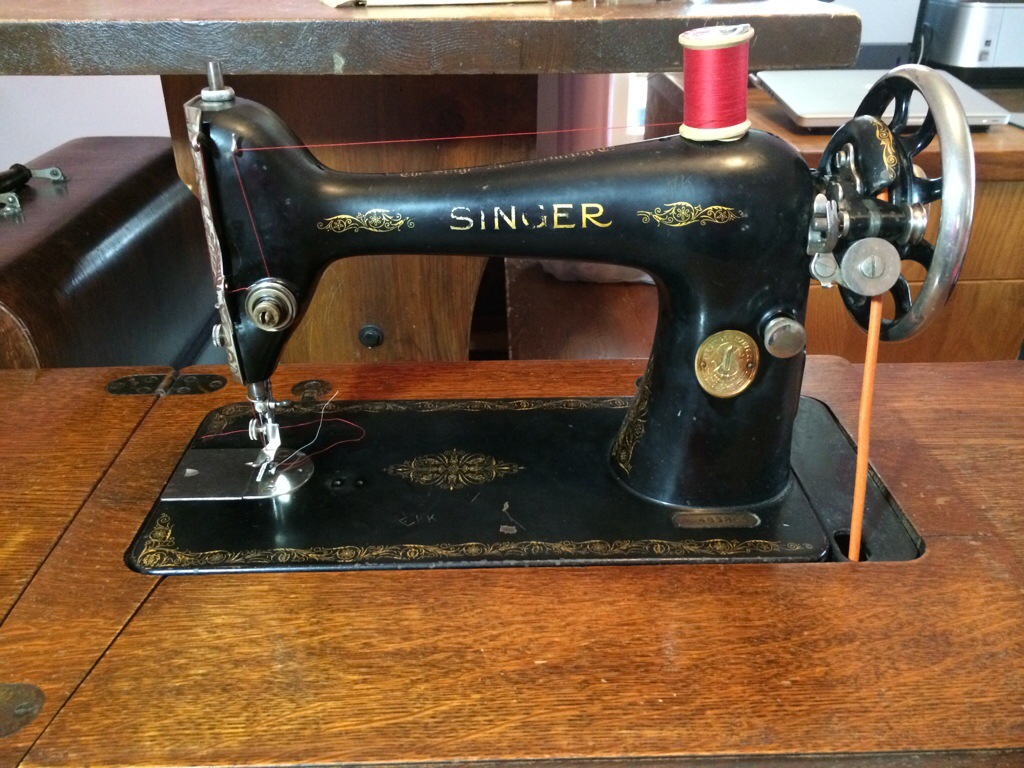 Meet Ruthie. She’s an 85 year old shirt-tail relative, who joined my family a couple weeks ago. She’s my dad’s wife’s daughter’s husband’s grandmother’s. She shows her age in more than just her style, but also in her wear–which also shows she was well loved and used. She needed a little help in a few areas, but still gets along pretty good for an old gal.
Meet Ruthie. She’s an 85 year old shirt-tail relative, who joined my family a couple weeks ago. She’s my dad’s wife’s daughter’s husband’s grandmother’s. She shows her age in more than just her style, but also in her wear–which also shows she was well loved and used. She needed a little help in a few areas, but still gets along pretty good for an old gal.
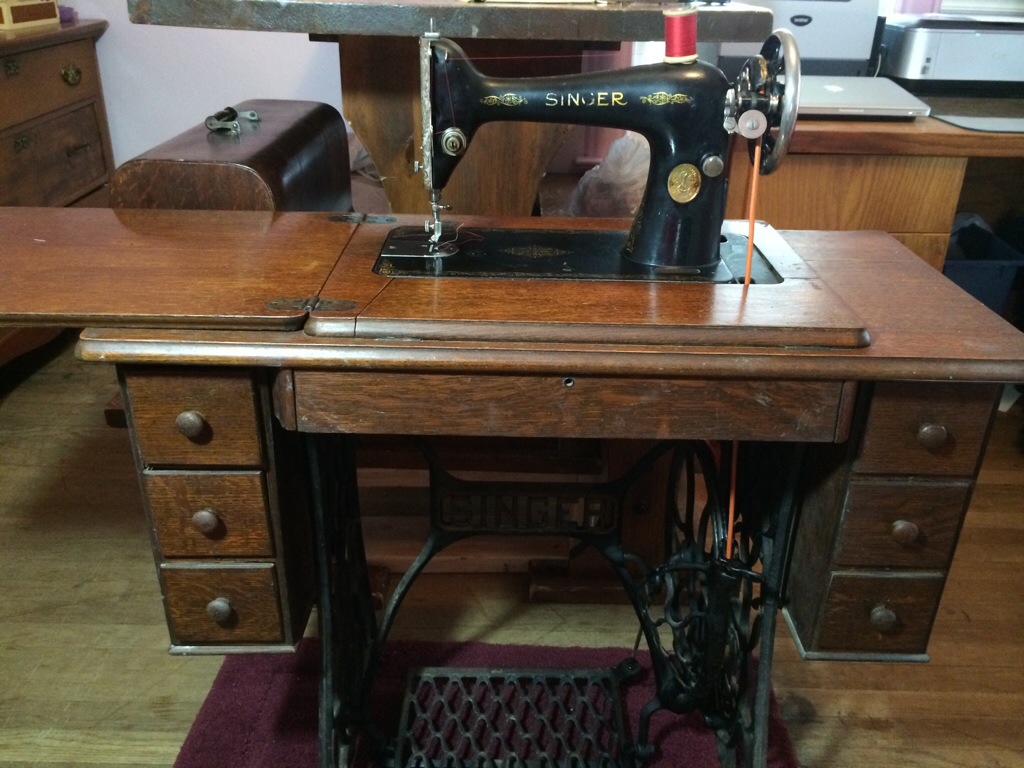
Ruthie needed a good bath–a thorough, long scrub. She will never look like a spring chick, but not bad for an old gal. Her wear tells her life’s story, which continues as, after her scrubbing, oiling, and a new belt, tire, bobbin and needle, she is back to faithfully doing what she has always done. (I still have a stripped screw to try to replace and work to do on her cabinet.)
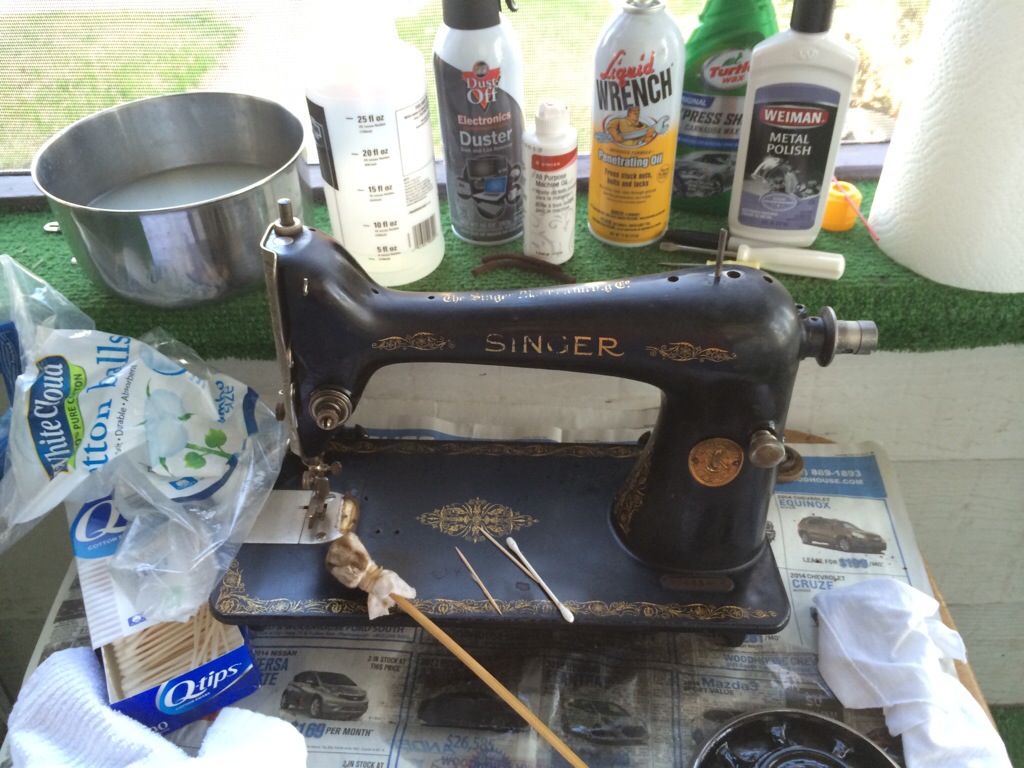
Ruthie, originally owned by Ruth Weiden, is a 1929 Singer 66 treadle with Filagree decals, in a Model 4, 7 drawer treadle cabinet. I’m happy to welcome her into my family. Thank you David and Nancy for allowing Ruthie to move in with me. She’s the first treadle to make it into my home. I wasn’t sure where she’d go, but when she was brought in, she was put at the end of my cutting table. She fits, so I think she’ll stay there. Maybe. (I still have another treadle to bring home in a couple weeks.)
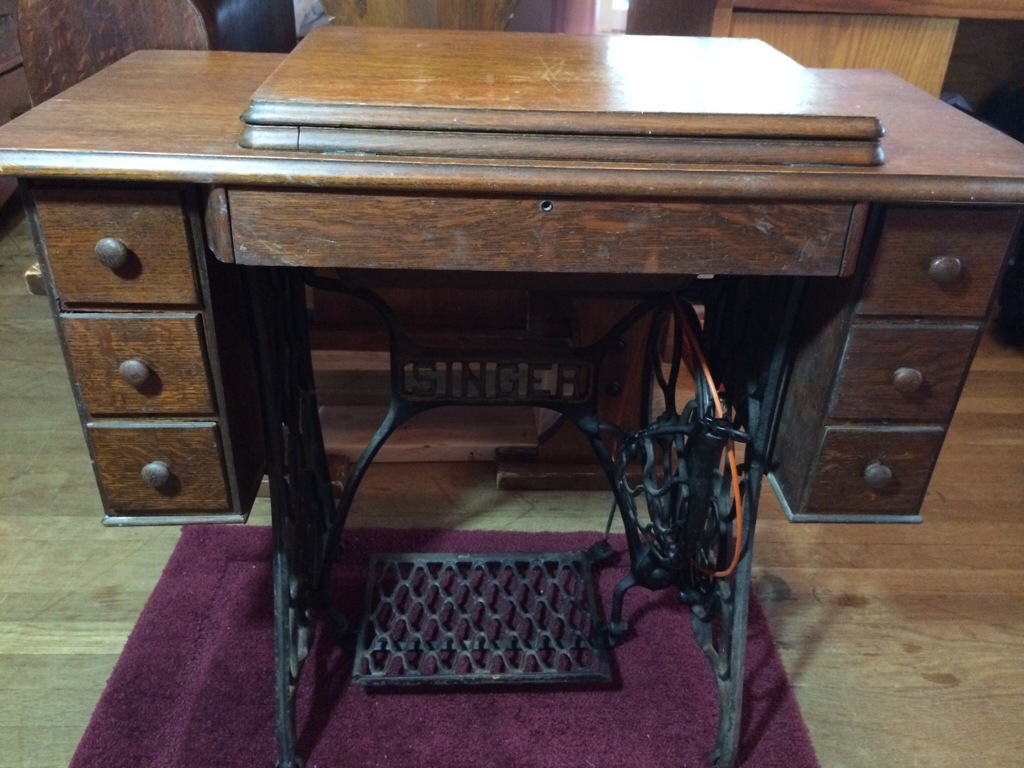
I’m not the only one who enjoys her soothing rhythm. My 2 youngest boys have taken a delight in treadling away with her.
You know, I’ve told you before, how doing something creative is relaxing and brain building. Well, you can increase those benefits by treadling. The rhythm of treadling is truly soothing, and it is said that people can treadle longer and with more enjoyment for longer time periods than when using an electric sewing machine. As an added bonus, treadling is good exercise. Need to get those added steps in for the day? Treadle them away.
Have you ever used a treadle sewing machine?
I love sewing. I love antiques. Add the 2 together and you have a love for antique/vintage sewing machines. I particularly love the beautiful black, curvy ones, that classic shape of the early 1900’s Singers with black “japanned” paint jobs. Owning an old black treadle machine has always been a dream of mine, particularly a “red head” (red decals). Last year that dream began to take shape–in several steps.
In a spare bedroom at my dad’s sits a treadle. Last year I told him, if it hadn’t already been promised to someone else, I’d like to have it some day–and I’d like to come look at it. When we opened it, we were surprised to find not a treadle machine, not even one that had been converted from a treadle. From my research, I found it to be a 1948 Singer 201-2, a machine that I’d love to (and will) own, even if not a treadle. I’ve already named her Pamela, after my sister who died as a baby in 1948, and since she is coming from my dad.
When I told an older lady how excited I was about that, she asked if I’d like to have her grandmother’s machine. Would I?!!! I’d seen it’s bentwood case in a spare bedroom at her house. It was time to find out just what was inside. A 1922 White Family Rotary that had originally been a treadle, but great grandma had put a swing-away motor on it and put it into the bentwood case, making a–very heavy–portable. I had to name her Betty! since she is a White and was “born” in 1922.
2 very old machines. Both close to treadles–but not. But cherished for what they are, not what they aren’t.
Since I now had a sewing room that was not also someone else’s bedroom or the schoolroom or playroom, or a hole in the wall in the attic, I started looking more actively for the treadle machine. By now, having studied enough about old sewing machines that I could identify many, Singers at least, I had a growing appreciation for old machines other than treadles. Although I’d looked at many–many times–nothing was ever quite what I was looking for, nor at a price I was willing or able to pay at the time. That treadle, that just surely called my name, never appeared.
Then, God…
decided to pour out an abundance on me–all within about 48 hours.
Last week, I found a machine on Craig’s List, about 100 miles away. It wasn’t a treadle, not even in any type of cabinet or case, but it was only $15 and they said it worked. It was also the only other model Singer made with the same motor as the one on dad’s machine–that didn’t work. I figured if the motor worked, even if I didn’t like the machine, or it didn’t run, I wasn’t out anything. They were right. She worked beautifully. Just needed a bit of cleaning–and probably some sort of case would be nice. I was now the owner of a 1952 Singer 15-91. I named her Louise, after my sister’s middle name, who was born in 1951 (close enough,) and passed in 1965.
The next day, I ran into a friend. She had noticed my old sewing machine posts, and told me she had one in her garage if I wanted to come look. If I wanted it, we could set up a trade (for essential oils). She didn’t know if it was treadle or not. It was buried in their garage. No treadle. But a cute little 1956 99K in a cabinet. I decided to take it, clean her up and see what she’d do. I had to name her Roxie Anne. 🙂 She came from a Roxanne, Anne is the 5th top name in the 1950’s, in Scotland where this machine was made, and my middle name.
Not 24 hours later. I received a phone call from my dad’s wife’s daughter. She’d been talking to my dad and he told her about my machines. She has her husband’s grandmother’s machine. She doesn’t sew or have room for it, and no daughters or daughter-in-laws to pass it on to. She’d love to give it to me. It’s a…
1929 Singer 66 TREADLE! Never been converted to electric. Works. And… I just “happen” to be going that way–in less than a week.
Picture to come soon! 🙂
Do you have an old sewing machine? Is there one you want?
 In doing some sewing machine research, I came across an article I’d like to share with you. Some real wisdom and clear vision put forth here.
In doing some sewing machine research, I came across an article I’d like to share with you. Some real wisdom and clear vision put forth here.
…The fact of the matter is, many of the skills and life choices often associated with modern survivalist living or prepping, were at one time the everyday skills and choices of simple living and traditional, old fashion common sense. …
I found it curious that a way of life that would have been considered quite normal and middle class in western Pennsylvania in the 1920s, 1930s, 1940s, 1950s, 1960s & 1970s, was by the year 2000, considered to be extraordinary, radical and a tad kooky.
I also found it interesting that in less than 2 generations the average American household had become for the most part, an isolated and non-productive, debt driven economic model.
The concept of a traditional and contained productive household economy had become alien. …The average American housewife from 1920 – 1970 would today be considered a survivalist. …
Quotes from article by “Granny Miller”
Click to read the whole article
Just a couple pictures today of the fun I’ve been having. {Even I’m not sure if that was a sarcastic statement or not.} 🙂
What kind of crazy sews so many itty-bitty half square triangles? It’s bad enough to sew–and press– 1″ squares, but crazy to cut those into half square triangles and rectangles. #whatwasithinking #gladthatsover In addition to the needle book and pin cushions, I plan to use most of the others in my sewing machine cover/mat. {Instructions for all coming soon.}
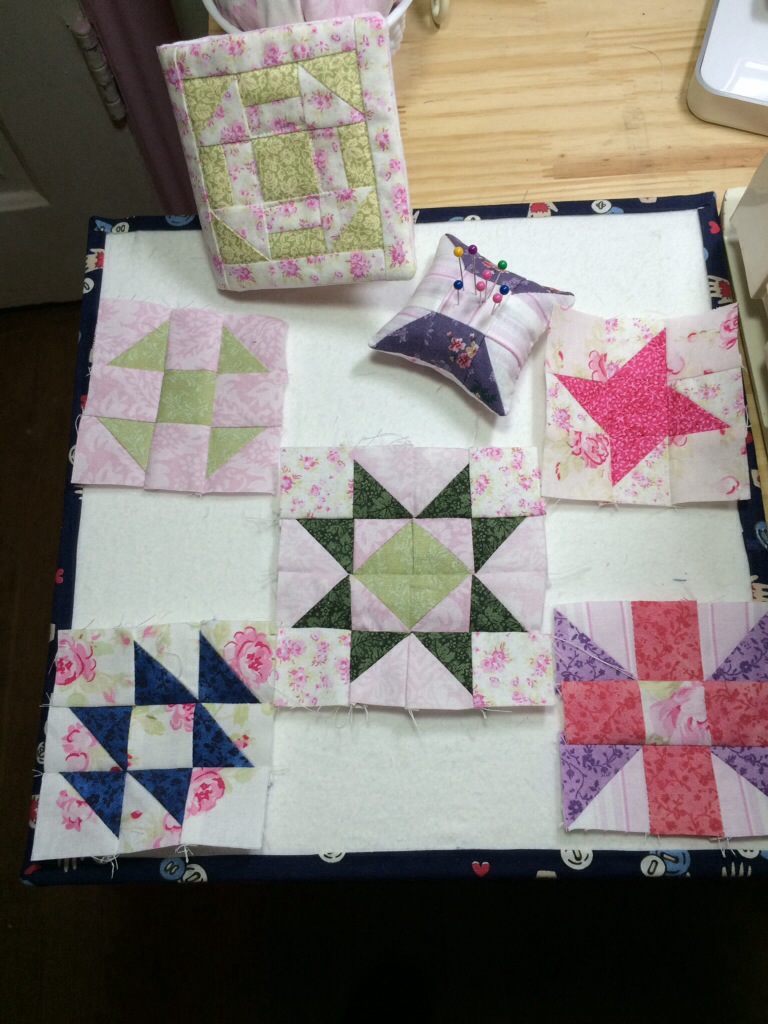
So what do I do? Practice a couple new techniques for Flying Geese– to make a huge, 12″ block, that I don’t have a clue what I’m going do with. They did turn out nice, but I have no plans of making a full size quilt at this time, so… what to do with it?
What size quilt blocks do you prefer to make?